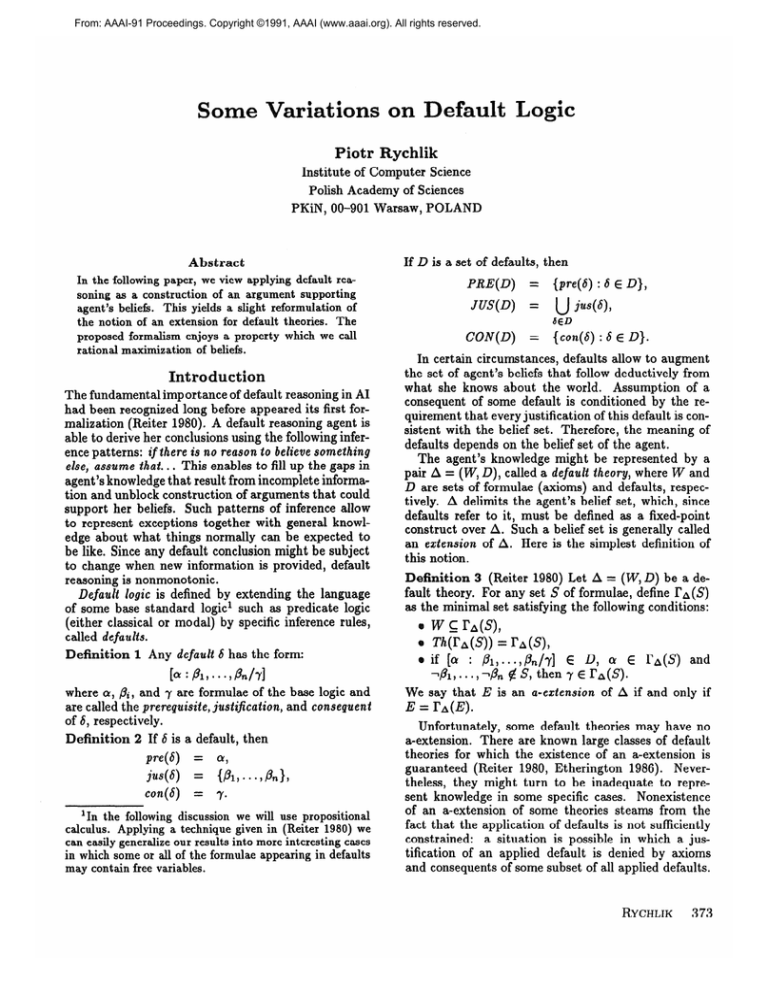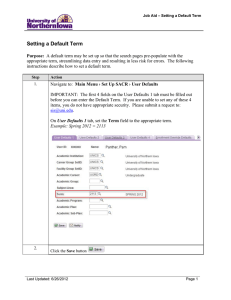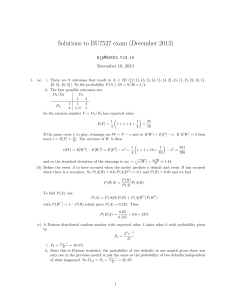
From: AAAI-91 Proceedings. Copyright ©1991, AAAI (www.aaai.org). All rights reserved.
Some Variations
efault Logic
0
Institute of Computer Science
Polish Academy of Sciences
PKiN, 00-901 Warsaw, POLAND
If D is a set of defaults, then
Abstract
In the following paper, we view applying default reasoning as a construction of an argument supporting
agent’s beliefs. This yields a slight reformulation of
the notion of an extension for default theories. The
proposed formalism enjoys a property which we call
rational maximization of beliefs.
Introduction
The fundamental importance of default reasoning in AI
had been recognized long before appeared its first formalization (Reiter 1980). A default reasoning agent is
able to derive her conclusions using the following inference patterns: if there is no reason to believe something
else, assume that. . . This enables to fill up the gaps in
agent’s knowledge that result from incomplete information and unblock construction of arguments that could
support her beliefs. Such patterns of inference allow
to represent exceptions together with general knowledge about what things normally can be expected to
be like. Since any default conclusion might be subject
to change when new information is provided, default
reasoning is nonmonotonic.
Default logic is defined by extending the language
of some base standard logic1 such as predicate logic
(either classical or modal) by specific inference rules,
called defaults.
Definition 1 Any
default6 has
the form:
A/71
where cy, pi, and 7 are formulae of the base logic and
are called the prerequisite, justification, and consequent
of 6, respectively.
[a
: I%,-*,
Definition 2 If S is a default, then
pre(S)
=
a,
jus(S>
con(S)
=
=
~P~,-dnh
7.
‘In the following discussion we will use propositional
calculus. Applying a technique given in (Reiter 1980) we
can easily generalize our results into more interesting cases
in which some or all of the formulae appearing in defaults
may contain free variables.
PRE(D)
=
(pre(6)
: 6 E D},
JUS(D)
=
CON(D)
=
U jus(S),
6ED
(con(s) : 6 E D}.
In certain circumstances, defaults allow to augment
the set of agent’s beliefs that follow deductively from
what she knows about the world. Assumption of a
consequent of some default is conditioned by the requirement that every justification of this default is consistent with the belief set. Therefore, the meaning of
defaults depends on the belief set of the agent.
The agent’s knowledge might be represented by a
pair A = (IV, D), called 8 defadttheory, where W and
D are sets of formulae (axioms) and defaults, respectively. A delimits the agent’s belief set, which, since
defaults refer to it, must be defined as a fixed-point
construct over A. Such a belief set is generally called
an extension of A. Were is the simplest definition of
this notion.
Definition 3 (Reiter 1980) Let A = (IV, D) be a default theory. For any set S of formulae, define I?h (S)
as the minimal set satisfying the following conditions:
@ w
E rA(s),
@ Th(rA(s))
e if [o
1 P l,...,
=
PA(s),
: &..,/347]
E D, a, E IA(s)
lPn fi! S, then 7 E r,(s).
We say that E is an a-eztension
E = rap).
and
of A if and only if
Unfortunately, some default theories may have no
a-extension. There are known large classes of default
theories for which the existence of an a-extension is
guaranteed (Reiter 1980, Etherington 1986). Nevertheless, they might turn to be inadequate to represent knowledge in some specific cases. Nonexistence
of an a-extension of some theories steams from the
fact that the application of defaults is not sufficiently
constrained: a situation is possible in which a justification of an applied default is denied by axioms
and consequents of some subset of all applied defaults.
RYCHLIK
373
Lukaszewicz (1988) modifies the notion of an extension
imposing new applicability criteria.
Definition 4 (Lukaszewicz 1988) Let A = (W, D) be
a default theory. For any two sets S and T of formulae, define I’i(S, T) and I’i(S, T) as the minimal sets
satisfying the following conditions:
0
0
e
w c rids, T),
Th(WsT))= Ws, T),
if[a:@i,...
, Pn/7] E D, o E I’i(S, T) and for all
~PETU{A,...
ybd, S U (7) Y 19, then
- 7 E q&T),
-
Pl,.*.
,A
E ri(S,
T).
We say that E is a b-extension of A with respect to F
F) and F = I’i(E, F).
if and only if E = I’#
This modification causes that every default theory
has a b-extension. Moreover, the new formalism has
the property of semimonotonicity,
which means that
introducing new defaults into a default theory does not
change any of the previously derivable beliefs.
In the following discussion, we will suggest and examine further changes to the notion of an extension.
Defaults
as arguments2
We claim that the definitions given in the previous section do not reflect the way in which some perfectly
rational agent would explain her own beliefs.
Suppose that all what the agent knows about the
world can be expressed by a simple default theory
(0, {al = CT : r/p], & = [T : s/p], d3 = [p : t/t]})
(1)
where T stands for a tautologically true formula. According to Definition 3 (or Definition 4), the only extension of (1) is Th( (p, t}). Let us observe that these
definitions force every default of (1) to be applied. A
perfectly reasoning agent, however, would notice that
in order to explain t, it is sufficient to refer to d3 and
one of the remaining defaults, either dl or d2. Referring
to both dl and d2 is somewhat redundant. Therefore,
there are two possible explanations why the agent believes t. She can use the following arguments: Since I
find r to be consistent with what I believe then, by dl,
I assume that p holds and hence, by d3, I can conclude
t. She uses defaults dl and d3 (in this order) as arguments justifying her belief in t. Of course, she can
use d2 and d3 (in this order) to achieve the same aim.
But in both cases, she realizes that it is superficial to
consider a default and think whether its justification
is consistent with her beliefs, if she already knows its
consequent.
This kind of reasoning seems to be manifested when
we attempt to explain something in the most concise
way. In such case, we try to use, for the sake of clarity,
only those arguments that are necessary to achieve our
2The proofs ofall cited theorems can be found in (Rychlik 1991).
374
NONMONOTONIC
REASONING
task. Lukaszewicz (1988) maintains that it is a worse
approximation of human reasoning than the one proposed in Definition 4. However, although people are
not logically omniscient, they seem to frequently use
such a pattern of inference, at least in simple cases.
Nevertheless, this kind of reasoning certainly can be
attributed to perfect reasoners.
Summarizing the above discussion, the perfectly
reasoning agent treats defaults as arguments choosing only those defaults whose consequents cause the
progress of the process of generating her own beliefs.
The question remains, how this new constraint imposed on applicability criteria for defaults changes the
notion of an extension. Not surprisingly, this new constraint does not change a-extensions. Let us recall that
the only condition that must be satisfied by a default in
order to include its consequent into an a-extension, is
that its justifications are consistent with some current
set of beliefs. It does not matter, therefore, if we use all
applicable defaults or only the “strongest”, whose consequents together with axioms entail the consequents
of all other potentially applicable defaults. Of course,
it might happen that there are no “strongest” defaults,
but if they exist, then in both cases, we would generate the same set of a-extensions. On the other hand,
b-extensions are vulnerable to this new policy of applying defaults. From the definition of a b-extension,
it follows that applying a default we have to check not
only whether all of its justifications are consistent with
some current set of beliefs, but additionally, if its consequent does not interfere with the justifications of the
previously applied defaults. It might happen, therefore, that restricting the application of defaults only
to the “strongest” unblocks some other defaults which
would otherwise remain inapplicable.
Let us formalize our intuitions concerning the rationally thinking agents and redefine the notion of an
extension for default theories.
Definition 5 By an indexed formula we will understand a pair (cy, 6) where (II is a formula and S is a
default or a special symbol e.
Definition 6 If S is a set of indexed formulae, then
/c(S)
=
U%4
F(S)
=
D(S)
=
{a : b, 6) E Sl,
(6 # e : (cr,S) f S}.
E Sl,
The next two definitions formalize what we will understand by a “stronger” default.
Definition 7 We say that an indexed formula (CY,6) is
weakly subsumed by a set S of indexed formulae if and
only if there is S’ E S such that (cy, S) e S’, F(S’) I- cr
and for every default 5 E ?>(S’) there is a sequence
so,. . . , S, E S satisfying the following conditions:
(a) for every 0 5 i 5 12, (CY,6) $$Si,
W F(S0)
t- pre(t),
(c) for every 1 5 i 5 n, r(Si)
t- PRE(ZJ(Si-I)),
(d) s, = 0.
To illustrate the above notion, let us consider two
sets of indexed formulae:
S’ = {sr,s2,ss}
and
S” = {sr,s2,ss,s4}
where
s3
= (a, P- : P/cd),
= (5 [4: +I),
= (uw~:4Q~4),
s4
=
31
s2
(qAt,[T:t/qAt]).
Let us note that sr is not weakly subsumed by Sf.
Although we have that F( {ss}) l- Q and F( (~2, ss}) lQ, the only sequence satisfying conditions (a)-(d) for
the default of sg, namely the sequence 8, {sr}, {sz},
fails to satisfy condition (u). On the other hand, sr is
weakly subsumed by Sff, because Sff > (~4) t- Q and,
for the default of ~4, the sequence consisting of only
one empty set of indexed formulae satisfies conditions
that is axioms and applied defaults, are recorded. It
essentially contains a trace of the agent’s reasoning.
Some of the flavor of the idea of recording the “history” of applying defaults is captured by some work in
inherit ante .3
The following theorem gives more intuitive characterization of a c-extension and closely corresponds
to the theorems proved in (Reiter 1980) and (Lukaszewicz 1988).
Theorem 1 If A = (IV, D) is a default theory, then
E is a c-extension for A with respect to a set F of
indexed formulae if and only if
60
00
and
E = U Ed
i=O
F = U Fi
i=o
where
Eo = W
and
FO = {(a,~)
: a E W},
for i 1 0
W-(d)*
E i+l = Z’h(Ei) U (7 : C} and Fi+l = Fi U ((7,s)
Definition 8 We say that an indexed formulaq is subsumed by a set S of indexed formulae if and only if
there is Sf C S such that c is weakly subsumed by Sf
and no element of S’ is weakly subsumed by S.
and C stands for the condition that there is 6 = [o :
E D such that a E Ei, for every ‘p E
Pl Y"'> &/r]
JUS(D(F)) u (PI,. . . , Al, E u {Y) Y ‘cp and (Y,q is
not subsumed by F.
Of course, if an indexed formula is subsumed by a set
of indexed formulate, then it is also weakly subsumed
by this set. However, the converse is not true. As an
example, let us consider the following infinite set of
indexed formulae:
A simple conclusion that follows from Definition 9
is that every c-extension is a set of formulae that are
entailed by axioms and consequents of applied defaults
of an underlying default theory.
s=
(sfJ,s1,...}
where si = (~0 A . . . A qi, [T : p/q0 A . . . A qi]), for
all i 1 0. It is easy to see that for every si E S,
(si+i} satisfies conditions (u)-(d), which means that
si is weakly subsumed by S, for any i 2 0. For the
same reason, no si is subsumed by S.
Definition 9 Let A = (W, D) be a default theory.
For any set S of formulae and any set T of indexed
formulae, define I’: (S, T) and I’i(S, T) as the minimal
sets satisfying the following conditions:
@ w c J%(sm,
e m(rt,(s,~)) = rh(s,q,
for all a
0 (QI,e} E rip, T)
E W,
e if S = [o : pi,. . . ,&Jy] E D, (;YE I$(S,T),
for
all 9 E JUWV))
U (PI, . . -, PA S U (7) Y -97
and (7,s) is not subsumed by 57, then
- Y E rpm,
- (7,s) E r; (s, T).
We say that E is a c-e&en&on of A with respect to F
and F = I’i(E, F).
if and only if E = I’i(E,F)
As in the case of b-extensions, I?; corresponds,
roughly speaking, to beliefs. I’; can be viewed as some
sort of a catalog in which all sources of information,
: E}
Theorem 2 Suppose E is a c-extension of some default theory with respect to F. Then E = Th(T(F)).
As we may expect, c-extensions, just as b-extensions,
also satisfy the next two theorems.
Theorem 3 Every default theory has a c-extension.
Theorem 4 (Semimonotonicity) Let D and D’ be sets
of defaults such that D E Df and suppose that A =
(VV,D) has a c-extension E. Then Af = (IV, 0’) has a
c-extension E’ such that E E E’.
There are many other similarities between the notions of a b- and c-extension. It is worth mentioning,
for example, that like b-extensions, c-extensions need
not to be maximal sets of beliefs, and hence, two different c-extensions do not necessarily have to represent
orthogonal sets of beliefs. As an example, let us consider the theory
(0, (4
= [T : q/d,
4 = [T : r/-p
A Y-I]}).
(2)
This theory has two c-extensions El C E2 with respect
to Fl and F2, respectively, where El = Z’h({-p}),
Fl = ((1p,dl)},
E2 = Th({-PAY})
and F2 = {(-PA
YQ, dz)}. El and E2 are also the only b-extensions of
(2). The only a-extension of (2) is E2.
3Some review material
found in (Rychlik 1989).
concerning
this issue can be
RYCHLIK
375
There are default theories, however, some of whose
b-extensions are not maximal sets of beliefs, whereas
all their c-extensions are. Let us examine an example
from (Lukaszewicz 1988) in which the following theory
is presented:
((PI, (4 = [T :
r/PI, d2 = ET: !I/-a).
(3)
This theory has two b-extensions El c E2 with respect
to Fl and F2, respectively, where El = Th((p}), Fl =
and F2 = (a}. But, Es with
{r}, ES = Th((p,v}),
respect to ((v, d2)) is the only c-extension of (3). E2
is also the only a-extension of (3).
Although examples (2) and (3) are very similar,
there is one important difference. In (2), a rationally
thinking agent believes that p holds, but she can choose
between two arguments that support this belief. One of
them blocks the assumption that r holds. In (3), there
is no need for her to justify p using defaults, because
she already knows it, and therefore she can conclude r.
We say that in such a case, the agent shows the ability to rationally maximize her own beliefs applying as
few defaults as possible. These intuitions are formally
described below.
Definition 10 Let E be an extension4 of a default
we will understand all detheory A. By GD(E,A)
faults used in generating E. If E is a c-extension of A
with respect to F, then GD(E, A) = ‘D(F).
Definition 11 Let A = (IV’,D) be a default theory
and E an extension of A. We say that a default S
is superfluous in GD(E, A) if and only if (con(S), S)
is subsumed by ((cy , E) : a E W} U {(con(t), 6) : t E
WE,
A>l.
Definition 12 Let E be an extension of a default theory A = (W, 0). We say that E is a rationally maximal
set of beZiefsif and only if there is no extension E’ C E
of A such that there is a default S E GD(E’, A) which
is superfluous in GD (E’, A).
Theorem 5 Every c-extension is a rationally maximal
set of beliefs.
One may wonder whether our approach offers any
advantages over Reiter’s or Lukaszewicz’s simpler formulations. The main advantage of a c-extension over
an a-extension is that the former is guaranteed to exist for any default theory, which is not the case for the
latter. On the other hand, for many representational
problems which involve default reasoning, our new formalization might give solutions that are less intuitive
than those supported by Reiter’s or Lukaszewicz’s formalizations (and vice versa).
In most knowledge representation systems, the intuitive meaning of a default [o : /?I,. . . , ,&/y] is that
normaUy, if cy is satisfied, then also 7 is satisfied unless some pi is assumed to be false. Let us return to
the example given above. The first default in (3) says
4 We mean here either an a-, b-, or c-extension.
376
NONMONOTONIC
REASONING
that normally p is satisfied unless r is assumed to be
false. In other words, the cases where p is satisfied and
r is known to be false are outnumbered by the cases in
which p and r are both satisfied. Given (3), a common
sense reasoner would conclude that, most probably, r
is satisfied. In this case, she would prefer El over Ea.
Suppose, however, that she is presented the following
default theory:
(
(PAS),
(
dl =[T:r/~l,
d2 = [T : q/v],
d3=[PAs:w/-r]
(4)
}
).
The above theory is similar to (3)) but additionally d3
says that normally r is false whenever p and s are satisfied. Since the only axiom of (4) says that p and
s are true, r is very likely false. A common sense
reasoner would, therefore, choose an extension which
Notice that (4) has two b-extensions
supports lr.
El = Th( (p A s}), which does not conform to our intuitions, and E2 = Th({p A s, v}).
E2 is the only
a-extension and c-extension of (4).
Finally, let us consider an example of a default theory
(
(
(eAce},
dl=[e:gA-)re/g],
d2 = [ce : re A -r/re]
}
)
(5)
given in (Besnard 1989). Assume the following interpretation of the predicate symbols:
e
-
Clyde is an elephant,
ce
-
Clyde is a circus elephant,
re
-
Clyde is a royal elephant,
!I r -
Clyde is gray,
Clyde is rare.
This theory has two b-extensions which are also the
only c-extensions. One of them contains the fact that
Clyde is a royal elephant. The other one supports the
assumption that Clyde is gray, which seems to be unintuitive. The only a-extension of (5) contains the fact
that Clyde is a royal elephant.
The above examples suggest that neither Reiter’s,
nor Lukaszewicz’s, nor our approach to default reasoning can be preferred overall.
Let us end our discussion with the following result:
Theorem 6 If A, B and C are sets of a-extensions,
b-extensions and c-extensions of some default theory,
respectively, then A E C 2 B.
Semantics
In this section, we will provide a model-theoretic seman tics of c-extensions for default theories. We will
use a technique proposed in (Etherington 1986) and
(Lukaszewicz 1988).
Any nonmonotonic logic can be viewed as a result
of transforming some base standard logic by a selection strategy defined on models.5 For default logics,
5See, for example, (Rychlik 1990).
this selection strategy consists, roughly speaking, in
restricting the set of models of the underlying default
theory. Suppose A = (W, D) is a default theory. Applying any default Sr E D whose conclusion does not
follow directly from W causes the class M{I of all models of W to be narrowed to the class M{61) of models
that satisfy the consequent of Sr. If we further apply another default S2 E D, the class m{dlI will be
narrowed to the class Mja,,~~l which contains those
models from Mfal) that additionally satisfy the consequent of 62. And so on. In this way we will obtain a
sequence MI) E !?R{61~C M{sl,aaI C . . . Every extension of A has its models among the maximal elements
of such sequences. Let us formalize these intuitions as
follows.
Definition 13 Let M be a set of models for some set
of formulae and F a set of indexed formulae. A default
is applicable with respect to
6 =
[a : Pl,...,PnlYl
(Z?R,F) if and only if for every m E 52, m b o, for
every cp E JUS(ID(F)) U {/3r, . . . , pn} there is m E !X
such that m + y A cp and (7, S) is not subsumed by F.
Definition 14 Let %Q and F be as above.
For a
default S = [o : /?I, . . . , pn/~], we construct two sequences Xc, X1, . . . and Yc, Yr , . . . as follows:
x0
=
Yo
=
{F u UY, Wh
{cEXO\X(F):C
is subsumed by X0)
and for i 3 0
X i+l
=
U
XEXi
Y*1+1 =
( U
{x\{cl})7
CEYi
(C E Xi+1 \ K(F)
: c is subsumed by Xi+r}.
fixi.
i=o
The result of S in (9$ F) (written s(%Z, F)) is either:
{(3n\{m:mj==~y},z):z~X}ifandonlyif6is
applicable with respect to (!JJ&,
F) and (7, S) 4 F,
(b) {(m, F)} otherwise.
(a)
Definition I.5 Let P be a set of pairs (9R, F) where
9R and F are defined as above. We say that
w
= u
({m:m~PAq},((PAq,dz)})
&
a2
Figure 1: Network corresponding to (6).
Definition 18 Let m and F be as above. Suppose (n
is a set of models for some set of formulae and D a set
of defaults. We say that (m, F) is accessible from rt
with respect to D if and only if there is a sequence (Si)
of defaults from D such that (%R, F) E (Si)(‘JT, K(F)).
Theorem 7 (Soundness) If E is a c-extension
default theory A = (W, D), then there is some
of indexed formulae such that ({m : (m b E},
stable with respect to D and accessible from the
models of W.
for
set
F)
set
a
F
is
of
Theorem 8 (Completeness) Let A = (W, D) be a default theory. If (m, F) is stable with respect to D and
accessible from the set of models of W, then !J.Ris the
set of models for some c-extension of A.
Put
x=
&
S(P)
PEP
is a result of S in P.
Definition 16 Let !JJZand F be as above. We say that
(9X, F) is stable with respect to a set D of defaults if
and only if for all S E D, S(lm, F) = ((9.R, F)} and
every element of F \ K(F) is not subsumed by F.
Definition 17 Let nZ and F be as above. Suppose
(Si) is a sequence of defaults. By (&)(!JR, F) we denote
U Ri where Ro = {(Z%R,F)} and for i 2 0, Ri+l =
b(R)-
We can envisage the semantics of default theories
as transition networks (Etherington 1986, Lukaszewicz
1988) whose nodes stand for pairs (m, F) and arcs
are labeled by defaults. If A = (W, D) is a default
theory then M represents some subset of all models of
W. The root node of the network for A is the node
From the node
: a! E W}).
({m : m I= WI, {(%4
(9.R, F), for every S = [a! : /?I,. . . , pn/r] E D, arcs
labeled S lead to the nodes S(%Q,F) as it is defined in
Definition 14.
Figure 1 represents a network corresponding to a
default theory
(~,(~~=[T:~/PI,~~=[T:~/PA~I}).
(6)
On Figure 2 a network corresponding to (3) is shown.
Conclusion
In this paper we introduced an alternative formalization of default reasoning. We presented, in the form of
RYCHLIK
377
Figure 2: Network corresponding to (3).
a fixed-point construct, a new definition of the notion
of an extension for default theories. Then we characterized this notion from the semantic point of view. We
also made an observation that extensions redefined in
such way represent so-called rationally maximal sets
of beliefs. We motivated our approach by noticing
that perfect reasoners tend not to use redundant arguments while explaining their beliefs about the world.
Of course, we know that there might be no single formalism in which we could reflect our intuitions about
how a perfectly reasoning agent should draw her inferences. A clash of different intuitions in formalizing
multiple inheritance with exceptions is a good example
supporting this observation. It seems, however, that it
is not difficult to modify a default logic so that it can
properly handle many of these intuitions.
References
Besnard, P. 1989. An Introduction to Default Logic.
Symbolic Computation Series, Berlin: SpringerVerlag.
Etherington, D. 1986. Reasoning from Incomplete Information.
Pitman Research Notes in Artificial Intelligence, London: Pitman Publishing Limited.
Lukaszewicz, W. 1988.
Considerations on default
logic: an alternative approach. ComputationaZ Intelligence, 4:1-16.
Reiter, R. 1980. A logic for default reasoning. Artificial Intelligence, 13:81-132.
Rychlik, P. 1989. Multiple inheritance systems with
exceptions.
Artificial Intelligence
Review, 3:159176.
Rychlik, P. 1990. The generalized theory of model preference (preliminary report). In Proceedings of the
Eight National Conference on Artificial Intelligence,
615-620. Menlo Park, Calif.: AAAI Press.
Rychlik, P. 1991. Modifications of default logic, Technical Report, Institute of Computer Science, Polish
Academy of Sciences. Forthcoming.
378
NONMONOTONIC
REASONING





